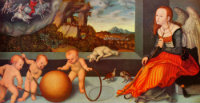Search:: Artists Alphabetically Artists by Country Artists by Century Artists by Movement
The Hidden Symbolic Meaning of Everyday Household Objects in Western Painting
A knife in a loaf of bread, a glowing candle, a dirty window, a childs toy on a shelf, a clock, an hourglass all are enchantingly decorative to the average onlooker. For painters of the Gothic, Early Renaissance and High Renaissance periods, everyday household items were part of a powerful visual language. William H. Hunt stated "When language was not transcendental enough to complete the meaning of a revelation, symbols were relied upon for heavenly teaching, and familiar images, chosen from the known, were made to mirror the unknown spiritual truth."
In a culture of limited literacy symbolic imagery was vital in enlightening the masses. Byzantine, Gothic and Early Renaissance paintings are rich in philosophical and Christian symbolism regarding common household objects.
Whisk broom- symbolizes marital faith.
Mirror - signifies vanity or an introspective nature.
A knife in a loaf of bread- symbolizes holy communion.
The glowing candle - a symbolic reminder of Christ's Passion.
A Childs toy - symbolizes the freedom and innocence of early life.
Glass prayer beads symbolic of the all-seeing wisdom of God.
Coins on top of a Bible - symbolizes the triumph of the material world over the pious and holy.
A red pillow- symbolizes hedonism and depravity of the soul.
A clock with missing hands - signifies mans powerlessness to control his own fate.
A lemon next to a salt shaker- symbolizes a doer of wicked deeds.
Hourglass - symbolizes the inevitable passing of time and the certainty of death.
Nails/Nails - The Crucifixion of Christ
A man dipping his hand into a bowl or serving platter represents Judas Iscariot at the Last Supper.
An overturned copper tea kettle - symbolizes loss of faith.
A rabbit on a white or silver platter- implies fertility.
A club - symbolizes martyrdom, Saint Jude, one of the apostles, was beaten to death with a club.
A fluttering blue of white curtain- symbolizes a heavenly world in which the splendor of the holy and divine is only beginning to be shown.
An unsheathed knife near a money purse or pile of coins- denotes a rebellious and materialistic viewpoint.
A burned out candle - symbolizes a lack of devoutness and piety.
A white or blue pitcher and basin - is a symbol of Purity, signifying clean thoughts and an uncorrupted essence. The pitcher and basin are also symbolic of forgiveness of sins, cleansing, sanctification, unity with God, eternal life, glory, theosis.
A dirty window- suggests physical malady (usually a venereal disease or leprosy); a polluted body.
A spilled or overturned inkwell- symbolizes broken promises, broken political treatise, missed chances. If the spilled inkwell is on the desk of a Saint then this symbolizes martyrdom; divine sufferers who spilled their blood in Gods name.
Lute - a musical instrument symbolic of romantic love.
The Meaning of Sacred Symbols in Paintings. Most prominently featured symbols and their meaning:
The Serpent
The Four Evangelists
If you feel you have worthwhile information you would like to contribute we would love to hear from you. We collect essential biographical information and artist quotes from folks all over the globe and appreciate your participation. When submitting please, if possible, site the source and provide English translation. Email to millardmulch@gmail.com
☼☼☼☼☼
☼☼☼☼☼
Search for Artists by Century Important Painters Born in the 13th Century Important Painters Born in the 14th Century Important Painters Born in the 15th Century Important Painters Born in the 16th Century Important Painters Born in the 17th Century Important Painters Born in the 18th Century Important Painters Born in the 19th Century☼☼☼☼☼
© HistoryofPainters.com 2017
If you like this page and wish to share it, you are welcome to link to it, with our thanks.

